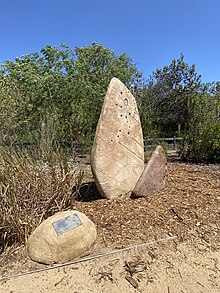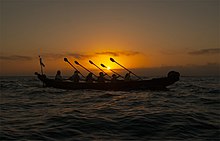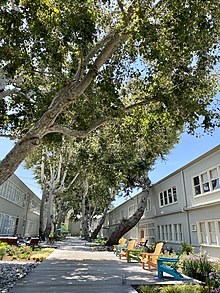
Guashna was a Tongva village located at Playa Vista, Los Angeles at the mouth of Ballona Creek. The site has also been referred to as Sa'angna (or some variation thereof), with various sources debating whether Sa'angna, meaning "place of tar," was a regional referent rather than a village name or whether it was a separate nearby village. The initial place name was said to be Sa'an; the village suffix "ngna" was added by Bernice Johnston to her 1962 map of Gabrieleño villages "despite her having found no mention of the term in baptismal records." Sa'angna is also not to be confused with Suangna. The Tongva referred to the Ballona Wetlands as Pwinukipar, meaning "full of water." Another alternate name may Waachnga.
Prior to the arrival of European settlers, tar located near the village, possibly at what was later renamed Baldwin Hill, was an important resource for the village in the construction of te'aats and for trade. In 2004, four-hundred burials in the area were unearthed in the construction of a drainage ditch in the Playa Vista development. The Tongva had little power to prevent the desecration despite numerous protests.
History
Prosperous village


Tar was reportedly an important resource of Guashna, which was used in trade with numerous neighboring villages and for the Tongva's production of te'aats to navigate the coastline.
The village was a point of departure to the island of Pimu (renamed Santa Catalina by the Spanish), which is located about twenty two miles from the village site, that had economic and cultural significance. Tongva's prosperous villages on the island would trade quarried soapstone, pierced white shell, abalone, and sea otter skins. Evidence of this trade can be found as far east as the native Pueblo peoples of what is now New Mexico. No other village throughout mainland Tovaangar was as important for coastal trade and connection with the islands.
The coastal village of Puvunga was a major regional trading center located about 20 mi (32 km) down the coastline.
Colonization


Like other Tongva villages in the area, the village declined with the arrival of Spanish missionaries and soldiers. The villagers were brought to Mission San Gabriel, where they were baptized and forced to work in conditions that were identified by third-party observers as being slavery "in every sense of the word."
At Mission San Gabriel, there were a total of 7,854 baptisms (2,459 children) and 5,656 deaths (2,916 children) until secularization in 1834, indicating a very high rate of death. Children often died very young at the missions. One missionary reported that three out of every four children born at nearby Mission San Gabriel died before reaching the age of two.
In the 1820s, while the villagers were at Mission San Gabriel and the village had been depleted, the governor of Alta California granted the land area, referred to as Guaspita, a variant of Guashna, as "a land grant received by Antonio Ignacio Ávila, which later was combined with the Salinas land grant to become Rancho Sausal Redondo, present-day Westchester." Mission registers of the era show a number of entries for people from Guasna and Guashna, or Guaspet, Guachpet, or Guashpet (-pet being a suffix that indicated someone was a person from a certain place.)
In W. W. Robinson's 1939 history of the area he wrote:
On old maps the cliffs of Ballona's easterly boundary are labeled Guacho, sometimes Huacho, an Indian term meaning high place, according to Cristobal Machado of Culver City, whose memory of La Ballona Valley goes back to Indian days. It was against these cliffs that the Indians built their brush-and-mud huts. From them the brown-skinned men went forth to gather clams and shell fish at the beach beyond the lagoon, to hunt small game in the marshes and to find edible berries, seeds and insects in the river growth and on hillside shrubs...The work of the ranch was done by the local Indians, one group of whom had their huts among the sycamores not far from Augustin's home , another group having their village against the cliffs beneath the present-day Loyola University.
The village is identified as Gaucha on George W. Kirkman's Pictorial and Historical Map of Los Angeles County from 1938.
Development

Until the 1960s, the village site was primarily used for cropland by the Machado family, remaining a natural spreading floodplain of Ballona Creek. Developments increasingly encroached on the agricultural area where the village site was located as Los Angeles sprawled outward.
In the 1990s, protests began to protect the village site from what was to be Dreamworks Studio at Playa Vista. After an environmentalist's hunger strike, director Steven Spielberg decided to not build the studio at that site.
In 2004, the construction of a drainage ditch for the Playa Vista development unearthed four hundred ancestral remains or burials in the area. California cemetery statutes that stem back to the 1850s, amidst the California Genocide, strategically excluded the protection of native cemeteries or burial grounds from desecration. The village site was disturbed for commercial and residential development without protection. As a non-federally recognized tribe, the Tongva had little control over their ancestral remains or artifacts to stop the development.
In 2005, "Phase II" of the Playa Vista development threatened to destroy the site. Continued developments in the area continue to threaten further destruction of the site as of 2021.
See also
References
- ^ Village at Playa Vista: Volume III (PDF). City of Los Angeles. 2009. pp. 21–24.
- Abdollah, Tami; Song, Jason (December 14, 2008). "Restoring harmony with reburial". Los Angeles Times. Retrieved December 26, 2022.
- "Ballona Discovery Park". Friends of Ballona Wetlands. Retrieved December 26, 2022.
- ^ "Tribal Cultural Resources Assessment for the Thatcher Yard Project, Los Angeles, California" (PDF). 2019.
- Gumprecht, Blake (April 30, 2001). The Los Angeles River: Its Life, Death, and Possible Rebirth. JHU Press. p. 218. ISBN 978-0-8018-6642-5.
- ^ Lepowsky, Maria (2012). The restless anthropologist : new fieldsites, new visions. Chicago: The University of Chicago Press. pp. 60–61. ISBN 978-0-226-30497-7. OCLC 780446639.
- Rochlin, Michael Jacob (1999). Ancient L.A. and other essays. Los Angeles: Unreinforced Masonry Studio. p. 69. ISBN 0-9648304-1-8. OCLC 43657353.
- ^ Lin, Sara (March 21, 2004). "State Decries Removal of Remains". Los Angeles Times. Retrieved December 26, 2022.
- Williams, Jennifer L (2007). "Grave Disturbances: Been Digging Lately". Public Resources.
- "At the Base of the Bluff" (PDF). July 2003. pp. 24–25.
- Street, Richard Steven (2004). Beasts of the Field: A Narrative History of California Farmworkers, 1769-1913. Stanford University Press. p. 39. ISBN 9780804738804.
a clerk with the Jedediah Smith fur-trapping party spent considerable time observing his San Gabriel mission surroundings. He soon found himself unable to tolerate the site of the natives working in the nearby vineyards and fields. 'They are kept in great fear, and for the least offense they are corrected,' he confided in his diary. 'They are... complete slaves in every sense of the word.'
- Guinn, James Miller (1907). History of the State of California and Biographical Record to Oakland and Environs: Also Containing Biographies of Well-known Citizens of the Past and Present (Digitized eBook). Historic Record Company. pp. 56–66.
- Singleton, Heather Valdez (2004). "Surviving Urbanization: The Gabrieleno, 1850–1928". Wíčazo Ša Review. 19 (2): 49–59. doi:10.1353/wic.2004.0026. JSTOR 1409498. S2CID 161847670 – via JSTOR.
- Robinson, W. W.; Title Guarantee and Trust Company (Los Angeles, Calif) (1939). Culver City: a calendar of events in which is included, also, the story of Palms and Playa Del Rey together with Rancho La Ballona and Rancho Rincon de los Bueyes. Los Angeles: Title Guarantee and Trust Co.
- Kirkman, George W. (1938). "Pictorial and Historical Map of Los Angeles County". tessa2.lapl.org. Los Angeles Public Library. 91.7941 L88Ki. Retrieved May 11, 2024.
- "TONGVA VILLAGE OF SAANGNA - Lands & Waters of Ballona, part of the Sacred Native American Site registered by John Tommy Rosas, tribal leader, Tongva Ancestral Territorial Tribal Nation (TATTN) | Grassroots Coalition". saveballona.org. Retrieved December 26, 2022.
External links
| Tongva villages | |||||||||||
|---|---|---|---|---|---|---|---|---|---|---|---|
| Los Angeles County |
| ||||||||||
| Orange County | |||||||||||
| San Bernardino County | |||||||||||
| Riverside County | |||||||||||
| Channel Islands | |||||||||||
|